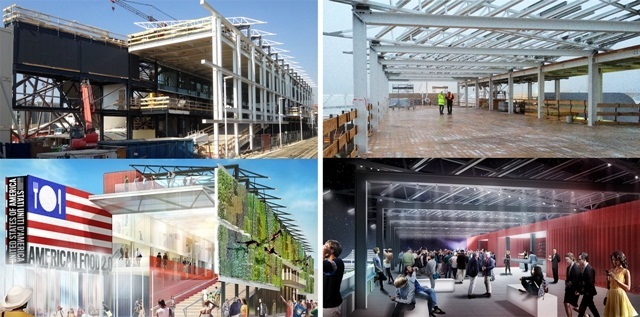Mar 20 2015
James Biber, the architect whose firm was selected after winning the competition to build the USA Pavilion at this year's World's Fair, Expo Milano 2015, will be highlighting the design aspects of the USA Pavilion at "Building the Expo," a special event being held from March 18 to 21, 2015 in Milan.
 The USA Pavilion at this year’s World’s Fair, Expo Milano 2015, has an all-glass roof using Research Frontiers' SPD-SmartGlass technology.
The USA Pavilion at this year’s World’s Fair, Expo Milano 2015, has an all-glass roof using Research Frontiers' SPD-SmartGlass technology.
"Building the Expo" is organized by the Milano Architettura Design Edilizia (MADE) and curated by Politecnico di Milano, and previews over thirty Expo Milano 2015 pavilions. The World's Fair, Expo Milano 2015, is expected to attract 20-30 million people from May through October, 2015.
The USA Pavilion features a vertical farm and an open design to create a feeling of transparency and spaciousness. The pavilion is topped by an all-glass SPD-SmartGlass roof using technology patented by Research Frontiers (NASDAQ: REFR) and manufactured under license by leading Italian glass company, Isoclima under their CromaLite brand of SPD-SmartGlass. A working full-sized CromaLite panel with three square meters (over 32 square feet) of SPD-SmartGlass is on exhibition this week at "Building the Expo."
According to the current designs for the USA Pavilion by leading international architect James Biber, each panel will switch in seconds from dark to clear, or any desired tint in between, in response to an automated control system. USA Pavilion visitors will also be able to instantly control individual panels in the roof from a touchscreen tablet, and by controlling individual panels in the roof which act as pixels, even messages can be displayed by the smart glass on the roof.
James Biber explained: "We chose SPD-SmartGlass because of its fast switching speeds from dark to clear, uniformity of change in tint over a broad range of light transmission, and the solar heat gain management benefits which will allow us to use very little energy to change the tint in the glass in the roof. The result is instant control in response to solar and weather conditions allowing us to maintain the comfort of visitors without air conditioning or heating. It helps create the open and transparent feeling that distinguishes the USA Pavilion from other Expo pavilions."
The USA Pavilion roof will have 312 very large panels of SPD-SmartGlass manufactured under license from Research Frontiers by Isoclima, a leading high-end glass manufacturer based in Este, Italy. Each panel measures approximately 1 meter by 3 meters, with a total surface area of over 10,000 square feet, making it the largest smart glass roof in the world.
SPD-Smart electronically dimmable windows and skylights reduce cooling energy requirements in the summer, and heating energy requirements in the winter, by maintaining a pre-selected ideal level of light and temperature. SPD-SmartGlass also blocks harmful UV rays at all times. By more effectively controlling daylighting, SPD-Smart windows also allow "daylight harvesting," which some independent sources estimate can save 35%-60% on lighting energy. With the growing pressure to reduce the energy use of buildings, many expect it to be a cornerstone of intelligent building design for years to come. Because SPD-SmartGlass can be retrofitted onto existing structures, even existing building stock can benefit from this green technology. This is significant as approximately 61% of all construction projects are retrofit projects, according to the U.S. Green Building Council.
SPD-SmartGlass technology has been selected as the exclusive smart glass for the USA Pavilion. SPD-Smart technology is the only smart glass technology that gives users the ability to instantly and precisely control the level of shading to any point between very dark and clear. This provides exceptional control over solar energy while also adding to user comfort, security, and protecting interiors. Available in glass or plastic, SPD-Smart windows can be controlled manually or automatically, and are currently being used in the automotive, architectural, aircraft and marine industries, and to protect priceless artifacts in museums from damage from visible light.